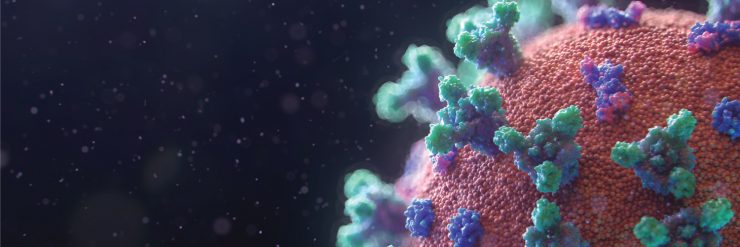COVID-19 has spread all over the world and has caused rapidly increasing confirmed cases and case fatalities. Geospatial technologies and services, which perform in real-time, are tremendously relevant to create a spatial health infrastructure. GIS and Remote Sensing Techniques have been used since the early days of 1694 for tracking the spread of contagious diseases.
This article focuses on how geospatial technologies can be used for tracking and communicating regarding the spread of the virus.
GIS provides mapping tools that help to deliver insights needed to plan, respond and help to slow the spread in the affected areas in the following ways:
1. Observe: Collecting real-time data of the cases in different regions and visualize the data through maps.
2. Understand: Analyse the case data, identify where the risk is high and prioritize interventions to those regions.
3. Respond: Deploy resources based on the maps and information through these maps to communicate the situation, so everyone stays aware.
GIS Potentials for Cobating COVID 19
COVID–19 Contact Tracing
Contact tracing is essential in tracking and breaking chains of transmission of COVID-19. It is the process of managing people by assessing their condition of health to prevent transmission to other people who come in close contact with them. Once locational information is added to contact tracing, it can help the public health department gather information about the highlighted places where the viral spread is happening in direct and prolonged contact between two individuals.
Tools like Link and Centrality analysis used in ArcGIS Pro can identify areas where the positive cases have come in direct or indirect contact with such positive cases. Analysis in link charts helps to understand how data is combined and how these connections relate to the network’s structure.
Here, link analysis is a technique used to evaluate relationships (connections) between nodes. Relationships may be identified among various types of nodes (objects), including organizations, people, positive cases, etc. Centrality finds and highlights the nodes that are the most connected.
There are four ways of measuring Centrality:
a) Degree, b) Betweenness, c) Closeness, d) Eigen Vector.
Once we have data of the patients with their addresses, the locations can be Geocoded.
COVID-19 tracking tools or contact-tracing apps are developing rapidly by different governments in their respective countries; one example is the Aarogya Setu.
Mapping and Tracking COVID-19 using Visual Analysis
The seamless integration of GIS with real-time COVID-19 diverse datasets related to public surveillance(active/confirmed cases, deaths, recovered cases) can help produce maps and allow the viewers to generate insights about the scenario over different regions. In addition, other countries have created various dashboards for real-time tracking of the COVID-19 data.
The COVID 19 data was collected, and maps were prepared to show the scenario for India.
This map represents the confirmed cases of COVID-19 till May 31st, 2021. As we already know, Maharashtra is most affected by COVID-19 and has cases as high as 57,46,892. Therefore, the total confirmed cases for India till May 31st, 2021, was 2,81,73,655.
The highest recovered number of recovered cases were also in Maharashtra though it has the highest confirmed cases. The total number of recovered cases in India was 2,59,39,504 till May 31st.
The highest deaths recorded were also in Maharashtra, which was 95,344. The total number of fatalities for India till May 31st was 3,31,909.
Case Fatality Rate (CFR) and Recovery Rate (CRR) were calculated for the Indian States and Union Territories.
For CFR, we have to take the total number of deaths and divide it by the total number of the confirmed cases. So, if ten people have died and 100 people have been diagnosed with the disease, then CFR is (10/100)*100, i.e., 10%.
Similarly, the Case Recovery Rate is the number of people recovering from total confirmed cases of COVID 19. Maps for these were also prepared.
CFR is not calculated in terms of total deaths to the total population, but total deaths to total confirmed cases, so the scenario is different in other states. Maharashtra has the highest number of recorded confirmed cases. Also, it has a very high CFR of 1.66%.
Still, however, Punjab has a relatively low number of confirmed cases of around 5,67,607 and low total deaths of 14,550, which, in general, to total death cases in India is low. Still, we here, take rate of the deaths per confirmed cases in Punjab it stands out to be high as 2.56%. Similar is the case with Sikkim, Mizoram, Manipur, Nagaland. For India,total CFR is 1.2%.
The highest Recovery Rate is observed in Delhi, which is as high as 97.53 %, whereas Tamil Nadu has a moderate recovery rate of 84.45%. Thus, the total recovery rate for India is 92.2%.
The above map has been created to help understand vaccine administration. The map shows the number of total vaccines, including first and second doses administered in each state from their supply. This information can better understand how the states are using their supply to initiate vaccination within their community.
India has administered around 21,60,00,000 doses of vaccine as of May 31st, 2021, which made a new landmark. The highest vaccine doses administered were for Maharashtra, which is 2,30,00,000.
Spatio-Temporal Analysis of COVID 19
Spatio-Temporal means an analysis over space and time. GIS tools were used in various domains for providing Spatio-temporal representation of COVID 19 for multiple domains like environment, socio-economic, cultural, and population health surveillance. The major spatial statistic tools involved in all domains target identifying risk-prone zones of COVID 19 and hotspots for the virus spread. In addition, various geostatistical techniques and models also are incorporated for identifying the spread.
a) Cluster Analysis
It deals with Spatio-temporal patterns of the spread of COVID 19 and identification of other aspects, which helps identify clusters of the active cases and relative risk assessment of affected sites at an early stage. Thus, this helps in early resource allocation, timely prevention, and mitigating the diffusion of the disease.
Cluster Analysis is a data analysis technique that clusters the sample observations into classes depending on the essential similarities within a category and dissimilarities among different classes found in the data set. Hierarchical cluster analysis is an algorithm that groups similar objects into groups called clusters.
There is variation between the clusters but similarity among the elements within the cluster. This explains the maximum chances of an input case to fall under a particular predefined cluster based on its Euclidean distance from that cluster’s mean. For example, different states and Union Territories can be divided into different clusters for each number of confirmed, death, and cured cases, depending upon risk categories.
If we go for a Non-Hierarchical Approach, then we can perform K-means clustering under the Multivariate clustering tool under spatial statistics under ArcGIS Pro. The Cluster-Outlier Analysis tool identifies high low clusters and the outliers.
b) Hotspot Analysis
The spatial clustering of high values is known as a hotspot, whereas the cluster with low values is known as a coldspot. This tool calculates the Getis-Ord Gi* statistic for each feature in a dataset. This tool looks at each feature with respect to that its neighboring features.
The p-value is the probability that the observed spatial pattern was created by some random process. When the p-value is very small, it is improbable (small probability) that the observed spatial pattern results from random processes, so the null hypothesis can be rejected.
The z-scores are standard deviations. Clustering of high values(hotspot) is indicated by a high z-score and small p-value after running this tool and also tells about a lower probability of being randomly selected.
A low z-score and small p-value indicate a spatial clustering of low values (coldspot) and are less probable to be chosen randomly, and a z-score of zero means no clustering. This tool can be applied for COVID 19 affected States and Union territories to identify hotspots and coldspots.
COVID-19 Susceptibility Mapping using Multi-Criteria Decision Analysis
First introduced by Saaty, AHP is a structured technique for organizing and analyzing complex decisions based on mathematics and psychology. It is a multi-criteria decision-making approach that uses different criteria for providing such solutions. GIS-based susceptibility mapping using AHP delivers the most accurate results.
AHP develops a hierarchy of decision factors through a pairwise comparison matrix. Different factors related to COVID 19 are considered, like population, population density, patients in quarantine, health care facilities, etc. And they can be assigned weights, and AHP can be carried out. Eigenvalues are calculated through weight rating. Eigenvalues are a unique set of scalars associated with a linear system of equations (i.e., a matrix equation). For susceptibility mapping using AHP, weights of each causative factor are obtained from the eigenvalues.
A Consistency Ratio (CR) is usually calculated by using the Consistency Index (CI), which uses the largest Eigenvalue and order of the pairwise comparison matrix. The Susceptibility Index (SI) is the product of the weight of the causative factor and the weighted value of the class of the causative factor. This is calculated for all the classes, and a district-wise map is generated based on susceptibility criteria.
COVID 19 Trajectory and Pandemic Paths and GIS
A trajectory is a curved path that an object takes as it moves through space over some time. The course of transmission of the COVID 19 pandemic was accelerated through various types of transportation. A complete analysis of spatial data, population density, types of traffic networks (airplanes, roads, ports), and their properties are presented in the figure below. GIS-based tools like interpolation, numerical methods, network analysis can be used to find the scenarios of virus distribution.
Integration of mathematics for COVID 19 includes Poisson distribution since there is an exponential growth of the pandemic and Geometric distribution for analysis of COVID 19 distribution. Poisson distribution helps to highlight the average time between the occurrence, which means the time between the start of the pandemic and the current situation. Geometric distribution explains the current stage of the pandemic.
With the road data, buffer analysis can be used. Railroads can be analyzed through squared buffers and circular buffers for analysis of ports. Kriging and interpolation methods can be used for Spatial heat map generation to show the confirmed cases’ distribution. Network analysis can be performed to find the centrality, modularity, and connectivity among the roads.
References
- Saran, S., Singh, P., Kumar, V. and Chauhan, P., 2020. Review of Geospatial Technology for Infectious Disease Surveillance: Use Case on COVID-19. Journal of the Indian Society of Remote Sensing, pp.1–18.
- Valjarević, A., Milić, M., Valjarević, D., Stanojević-Ristić, Z., Petrović, L., Milanović, M., Filipović, D., Ristanović, B., Basarin, B. and Lukić, T., 2020. Modelling and mapping of the COVID-19 trajectory and pandemic paths at global scale: A geographer’s perspective. Open Geosciences, 12(1), pp.1603–1616.
- Sarkar, S.K., 2020. COVID-19 Susceptibility Mapping Using Multicriteria Evaluation. Disaster Medicine and Public Health Preparedness, 14(4), pp.521–537.
- ZARGAR, S.A., ISLAM, T., REHMAN, I.U. and PANDEY, D., 2021. Use of Cluster Analysis To Monitor Novel Corona Virus (Covid-19) Infections In India. Asian Journal of Advances in Medical Science, pp.1–7.
- Sarfo, A.K. and Karuppannan, S., 2020. Application of geospatial technologies in the COVID-19 fight of Ghana. Transactions of the Indian National Academy of Engineering, 5(2), pp.193–204.
- https://www.esri.com/en-us/covid-19/overview
- https://api.covid19india.org
Written by Jeeshna Mukherjee, Geospatial Software Engineer, at SatSure. The story was first published on our Medium




